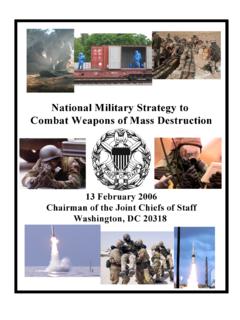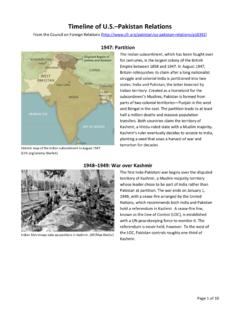Transcription of National Military Strategy to Combat Weapons of Mass ...
1 National Military Strategy to Combat Weapons of Mass Destruction 13 February 2006. Chairman of the Joint Chiefs of Staff Washington, DC 20318. TABLE OF CONTENTS. SECRETARY'S 2. CHAIRMAN'S 3. EXECUTIVE 4. CHAPTER 1: 9. CHAPTER 2: GUIDING PRINCIPLES .. 13. CHAPTER 3: STRATEGIC Military 16. CHAPTER 4: OPERATIONAL GUIDANCE .. 20. CHAPTER 5: CONCLUSION .. 28. ANNEX A: TERMS & 29. EXECUTIVE SUMMARY. The National Military Strategy (NMS) to Combat Weapons of Mass Destruction (WMD) is derived from the Department of Defense's (DOD) mission to dissuade, deter and defeat those who seek to harm the United States, its allies, and partners through WMD use or threat of use and, if attacked, to mitigate the effects and restore deterrence. Its purpose is to provide DOD Components guidance and a strategic framework for combating WMD. The Strategy uses an ends, ways, means approach to planning, executing and resourcing, and emphasizes those combating WMD missions in which the Military plays a prominent role.
2 Guiding Principles Six guiding principles underpin the National Military Strategy to Combat WMD. These principles should be used as a foundation for the development of all combating WMD concepts of operations and plans. Active, Layered, Defense-in-Depth. In order to protect the United States and defeat aggressors, the Armed Forces must establish an active defense. The Armed Forces will focus Military planning, posture, operations, and capabilities, in accordance with mission essential tasks, on the active, forward and layered defense of our nation, Six Guiding Principles our allies, partners, and interests. Situational Awareness and Integrated Active, Layered, Defense-in-Depth Situational Awareness and Integrated Command and Control. The decision Command and Control to employ specialized combating Global Force Management WMD capabilities for simultaneous Capabilities-Based Planning operations demands a highly flexible Effects-Based Approach and adaptive command and control Assurance process informed by timely, credible, and actionable intelligence.
3 Global Force Management. Any combating WMD capabilities we develop in the future must be visible to combatant command planners and include responsive and agile forces that can be rapidly task organized and equipped to accomplish assigned missions. Capabilities-Based Planning. We must plan for and develop capabilities that could be employed against a range of threats and associated capabilities while balancing the requirements for targeted strategies against known proliferators. Effects-Based Approach. We will use an effects-based approach in planning, execution, and assessments to achieve efficient results and reduce risk to mission and campaign objectives, as well as to our combating WMD-related resources. Assurance. Where possible, we will encourage action by like-minded States, work with our international allies, partners, and operate through regional States to Combat WMD actively.
4 Strategic Military Framework The strategic Military framework to Combat WMD consists of ends (the Military strategic goal and associated end state), 4. ways ( Military strategic objectives), and means (combatant commands, Military Departments, and Combat support agencies) applied across the three pillars of the National Strategy to Combat WMD (nonproliferation, counterproliferation, and consequence management). Ends ( Military Strategic Goal and Associated End state) Our Military strategic goal is to ensure that the United States, its Armed Forces, allies, partners, and interests are neither coerced nor attacked by enemies using WMD. Specific end states delineate standards by which we can measure our effectiveness: 1. Armed Forces, in concert with other elements of National power, deter WMD use. 2. U. S. Armed Forces are prepared to defeat an adversary threatening to use WMD and prepare to deter follow-on use.
5 3. Existing worldwide WMD is secure and the Armed Forces contribute as appropriate to secure, reduce, reverse or eliminate it. 4. Current or potential adversaries are dissuaded from producing WMD. 5. Current or potential adversaries' WMD is detected and characterized and elimination sought. 6. Proliferation of WMD and related materials to current and/or potential adversaries is dissuaded, prevented, defeated or reversed. 7. If WMD is used against the United States or its interests, Armed Forces are capable of minimizing the effects in order to continue operations in a WMD environment and assist United States civil authorities, allies and partners. 8. Armed Forces assist in attributing the source of attack, respond decisively, and/or deter future attacks. 9. Allies and civilian agencies are capable partners in combating WMD. Ways ( Military Strategic Objectives) The Military strategic objectives (MSOs).
6 Are achieved through eight missions conducted across the combating WMD. continuum. Defeat and Deter WMD use and subsequent use. Adversaries must believe they will suffer severe consequences and that their objectives will be denied if they threaten or resort to the use of WMD. Protect, Respond and Recover from WMD use. The purpose of this objective is to respond to an adversary who has used WMD on the battlefield or against strategic 5. interests. To protect and recover from WMD use, Armed Forces will execute passive defense measures and be prepared to conduct WMD. consequence management activities. Defend, Dissuade or Deny WMD. proliferation or possession. To prevent, Military Strategic Objectives dissuade or deny adversaries or potential adversaries from possessing or Defeat, Deter proliferating WMD, Armed Forces Protect, Respond, Recover will be prepared to conduct offensive Defend, Dissuade, Deny operations.
7 The Military must also Reduce, Destroy, Reverse support interdiction efforts, security cooperation, and nonproliferation efforts. Reduce, Destroy or Reverse WMD. possession. To reverse WMD programs and reduce WMD and related material stockpiles, the Armed Forces will support threat reduction cooperation as well as be prepared to assist in cooperative stockpile destruction activities. Means (Combatant Commands, Military Departments, and Combat Support Agencies). The combatant commands, Military departments, and Combat support agencies are the means to accomplish MSOs. Commander, Strategic Command (CDRUSSTRATCOM) is the lead combatant commander for integrating and synchronizing DOD in combating WMD. Consistent with this assignment, USSTRATCOM will integrate and synchronize applicable Department of Defense-wide efforts across the doctrine, organization, training, material, leadership, personnel, and facilities spectrum.
8 Combatant Commanders will continue to execute combating WMD missions within their AORs. Military efforts will need to be integrated with other organizations and nations that possess capabilities, resources, or information that can contribute to the mission. Strategic Enablers Strategic enablers are crosscutting capabilities that facilitate execution of the Military Strategy . They enhance the effectiveness and integration of Military combating WMD mission capabilities. Commanders must continually assess enabling capabilities and identify required improvements. Three strategic enablers facilitate DoD's efforts to Combat WMD: intelligence, partnership capacity, and strategic communication support. Intelligence. Intelligence directly supports Strategy , planning, and decision-making;. facilitates improvements in operational capabilities; and informs programming and risk management. To reduce uncertainty, our intelligence capability must exploit a variety of sources, facilitate information sharing, and improve situational awareness.
9 Partnership Capacity. Building partnership capacity, bilaterally and multilaterally, enhances our capability to Combat WMD. We should build on and leverage Government, Non-Government Organizations, corporate 6. Strategic Enablers Intelligence and international partner capability. Partnership Capacity Security cooperation efforts should not Strategic Communication Support only focus on missile defense cooperation or the Proliferation Security Initiative (PSI), but equally stress passive defense, elimination, and WMD consequence management cooperation. Strategic Communication Support. The Military plays a significant supporting role in the larger Government effort to communicate and demonstrate our resolve. Strategic communications shape perceptions at the global, regional, and National levels. words and actions reassure allies and partners and underscore, to potential adversaries, the costs and risks associated with WMD acquisition and use.
10 Military Mission Areas The Military mission is to dissuade, deter, and defeat those who seek to harm the United States, its allies, and partners through WMD use or threat of use. This mission is in direct support of the three pillars (nonproliferation, counterproliferation, and consequence management) of the National Strategy for combating WMD. Across the four Military strategic EIGHT MISSION AREAS. objectives, Armed Forces may be called upon to carry out eight missions: offensive Offensive Operations operations, elimination, interdiction, active Elimination Operations defense, passive defense, WMD consequence Interdiction Operations management, security cooperation and Active Defense Passive Defense partner activities, and threat reduction WMD Consequence Management cooperation. Capabilities development Security Cooperation &. should address and prioritize the critical Partnership Activities capability needs of these eight mission Threat Reduction Cooperation areas.









